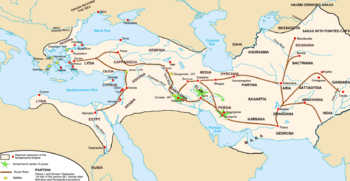Eber-Nari
| Eber-Nari | |||||
| Province of Achaemenid Empire | |||||
| |||||
|
Standard of Cyrus the Great | |||||
| Historical era | Achaemenid era | ||||
| - | Conquest of Chaldea | 539 BCE | |||
| - | Conquests of Alexander the Great | 332 BCE | |||
Eber-Nari (Akkadian, also Ebir-Nari) or Abar-Nahara עבר-נהרה (Aramaic) was the name of a region of Western Asia and a satrapy of the Neo-Assyrian Empire, Neo-Babylonian Empire and Achaemenid Empire, which roughly corresponded with the Levant. It means "Beyond the River" or "Across the River" in both Akkadian and Aramaic (that is, the Western bank of the Euphrates from a Mesopotamian and Persian viewpoint). It is also referred to as Transeuphratia (French Transeuphratène) by modern scholars. The province is also mentioned extensively in the Biblical books of Ezra and Nehemiah.
The toponym appears in an inscription of the 7th century BC Assyrian king Esarhaddon.[1] In 535 BC the Persian king Cyrus the Great organized most of the newly conquered territories of the former Neo-Babylonian Empire as a single satrapy, "Babylonia and Eber-Nari".[2] The satrap resided in Babylon and there were subgovernors in Eber-Nari, one of which was Tettenai, mentioned in both the Bible and Babylonian cuneiform documents.[3] This organization remained untouched until at least 486 BC (Xerxes I's reign), but before c. 450 BC the "mega-satrapy" was split into two—Babylonia and Eber-Nari.[4]
Herodotus' description of the Achaemenid tax district number V fits with Eber-Nari. It comprised Syria, Phoenicia, and Cyprus (which was also included in the satrapy[5]). Herodotus did not include in the tax list the Arabian tribes, identified with the Qedarites,[6] that did not pay taxes but contributed with a tax-like gift of frankincense.
Notes
References
- Dandamaev, M (1994): "Eber-Nari", in E. Yarshater (ed.) Encyclopaedia Iranica vol. 7.
- Drumbrell, WJ (1971): "The Tell el-Maskuta Bowls and the 'Kingdom' of Qedar in the Persian Period", BASOR 203, pp. 33–44.
- Olmstead, AT (1944): "Tettenai, Governor of Across the River", JNES 3 n. 1, p. 46.
- Stolper, MW (1989): "The Governor of Babylon and Across-the-River in 486 B.C.", JNES 48 n. 4, pp. 283–305.
- Tuell (1991): "The Southern and Eastern Borders of Abar-Nahara", BASOR n. 284, pp. 51–57.
- Parpola, S (1970): "Neo-Assyrian Toponyms, Alter Orient und Altes Testament". Veröffentlichungen zur Kultur und Geschichte des Alten Orients und des Alten Testaments 6, Neukirchen-Vluyn, p116
- Zadok, R (1985): "Geographical Names According to New and Late-Babylonian Texts", Beihefte zum Tübinger Atlas des Vorderen Orients, Répertoire Géographique des Textes Cunéiformes 8, Wiesbaden, p129
| |||||||||||||
.svg.png)
